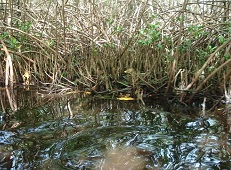There is no clear theory about the etymological origin of mangroves. Specifically, it is established that it derives from "mangrove." This term, which means "type of bush" has different opinions about its origin. Thus, there are those who believe that it derives from Guaraní, there are those who believe that it emanates from Arauca, those who think that it comes from Malay...
Mangroves are lands that, when the tide rises, are covered with water . In these areas there are estuaries that give rise to numerous islands, in which species of flora that subsist in salt water develop.
 Considered biomes , mangroves are found in subtropical or tropical regions , both on the coast and in estuaries. They are generally noted for their rich biodiversity , with an abundant presence of mollusks, fish and other animals.
Considered biomes , mangroves are found in subtropical or tropical regions , both on the coast and in estuaries. They are generally noted for their rich biodiversity , with an abundant presence of mollusks, fish and other animals.
The aforementioned mangrove that we have already mentioned, it must be emphasized that it is a shrub from the rhizophoraceae group that can reach a height of up to four meters. Mangroves have hanging branches that take root and intertwine, creating networks that serve as shelter for various species .
In mangroves there are usually a large number of mangroves. These bushes function as a natural barrier against the wind and even provide protection from the advance of waves. That is why they are very valuable in stopping erosion .
In addition to all the above, we cannot ignore that there are different types of mangroves. Among them, some stand out such as the following:
-Edge mangroves, which are those that form in the bays. Its trees do not exceed 20 meters in height.
-Riparian mangroves, which are those that occur in river beds. Its plant species reach 30 meters in height.
-Dwarf mangroves, which are those that exist in areas of low temperatures and where there are high concentrations of salt.
-Bar mangroves. These, as their name indicates, are protected by a sand barrier. They are produced, above all, in areas of the Pacific.
-Islet mangroves are, for their part, that are developed in beach areas that are isolated and have large amounts of mud. In them, the trees do not exceed 10 meters in height.
-Basin mangroves, which are very common to find in depression areas.
In the same way, we cannot ignore the fact that among the countries that have the greatest number of important mangroves are Mexico, Ecuador, Panama and Colombia.
The Madagascar mangrove forest , for example, is located on the west coast of this African country. It covers an area of about 5,500 square kilometers and is the habitat of the green turtle, the Nile crocodile and the Malagasy heron, among other creatures.
The Piura mangroves , also called San Pedro mangroves or Vice mangroves , are located at the mouth of the Piura River , in Peru . A large number of shorebirds live there.
Other mangroves of ecological relevance are the mangroves of New Guinea , in Oceania . The flora and fauna of this region are very varied.
